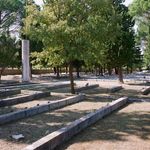Guided tour in English
Guided tour in English of the exhibition Unfinished modernisations / between utopia and pragmatism
UGM | Maribor Art Gallery, Strossmayerjeva 6
Thursday, 12 April 2012 at 17.00
Guided by: Maroje Mrduljaš, curator
The objective of the exhibition Unfinished Modernisations is to throw light on the spaces produced by the socialist modernisation of Yugoslavia and what happened with these spaces after the collapse of the common state and the disappearance of socialism. The focus of the exhibition is on the physical space; on the production of cities, one of the fundamental means of socialist modernisation; and on the role that architecture and urban planning had in this production. But we are also interested in other spaces in which this production unfolded and that had a fundamental part in determining it, spaces that were geopolitical, economic, ideological and so forth. The exhibition thus tracks the different scales of the production of built space, such as the global geopolitical scale and the scale of the Yugoslav political union, on which various forms of cultural and technological and economic exchange took place. The exhibition will draw on the collective knowledge of those taking part in the Unfinished Modernisations project, the aim being to identify and map out the modernisation processes in the whole region, which have been insufficiently explored, to identify the interruptions in and continuities of the process, as against the current transformations of the built environment. Modernisation processes inherited from the socialist period in Yugoslavia are particularly evident in the built space. Urban planning was at that time one of the main tools for the transformation of a pre-modern to a modern society, which is equated ideologically with the construction of self-managing socialism. The processes of modern planning had been started before, and had achieved various levels in different settings in Yugoslavia; however, after World War II they speeded up drastically, compressing those processes that in the "centres of modernisation" had unfolded over a much longer time into short periods or "waves". But these processes were often unfinished and incompletely articulated. This incompleteness culminated in the breakup of the state itself in the nineties. The conditions for the production and use of the built environment were changed radically, which included, of course, architectural culture and its products.
Maroje Mrduljaš (1971, Rijeka) graduated at the Faculty of Architecture in Zagreb. Author of numerous exhibited, published and awarded architectural and urban-planning competition projects and studies. Awarded second prize at the 38th Zagreb Salon in 2003. Has published essays, outlines and critical texts in the areas of architecture, urban planning, design and visual arts since 1995. He is editor of the 'Plan' collection at AGM, member of editorial board of the journals Život Umjetnosti, Up & Underground and Oris. Member of the Croatian section AICA, and autonomous expert of the Mies van der Rohe Award. Employed as a research assistant at the Faculty of Architecture, Zagreb.
FREE ENTRY!
